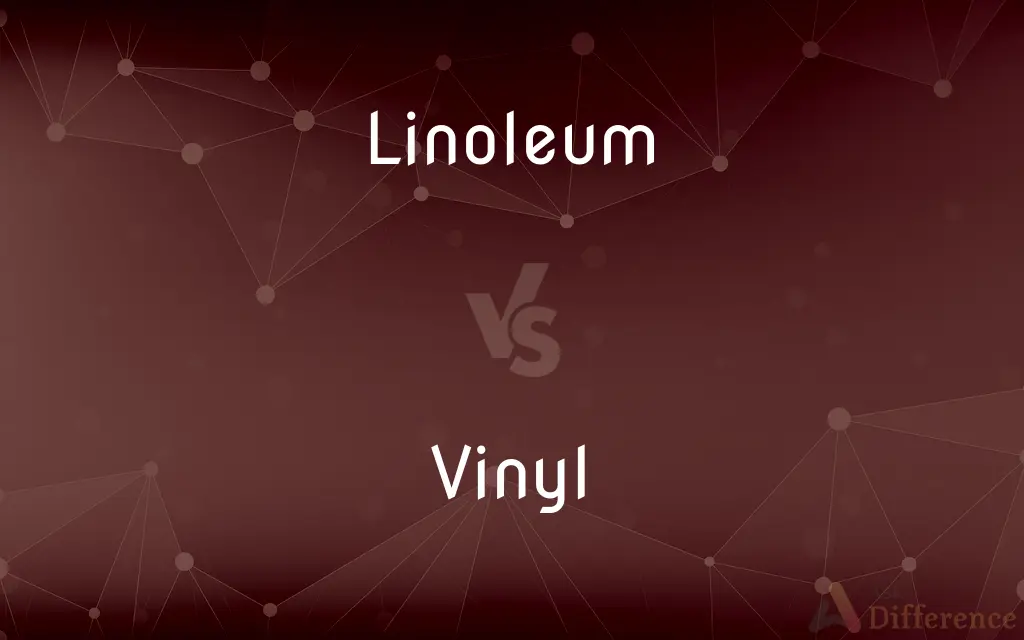Linoleum vs. Vinyl — What's the Difference?
By Tayyaba Rehman — Updated on September 22, 2023
Linoleum is a natural flooring material made from linseed oil and cork, while Vinyl is a synthetic material derived from petroleum products.

Difference Between Linoleum and Vinyl
Table of Contents
ADVERTISEMENT
Key Differences
Linoleum and Vinyl are both popular choices for flooring but are made of different materials. Linoleum is derived from natural substances like linseed oil, cork dust, and wood flour. In contrast, Vinyl is a synthetic product made primarily from petroleum-derived chemicals.
While both Linoleum and Vinyl are durable and easy to maintain, their origins result in distinct environmental footprints. Linoleum is biodegradable and can last up to 40 years, making it an eco-friendly option. On the other hand, Vinyl, being synthetic, may release volatile organic compounds (VOCs), especially when new.
In terms of aesthetics and design flexibility, both Linoleum and Vinyl have their merits. Linoleum's color permeates throughout the material, so scratches are less noticeable. Vinyl, however, offers a broader range of patterns and designs, often mimicking other materials like wood or stone.
Cost is another differentiating factor between Linoleum and Vinyl. Linoleum tends to be more expensive initially but might be cost-effective in the long run due to its longevity. Vinyl, being more affordable upfront, is a go-to choice for many looking for budget-friendly flooring options.
Lastly, installation and maintenance vary between Linoleum and Vinyl. Linoleum might require a more experienced hand for installation, while Vinyl is often praised for its ease of installation. Both materials are water-resistant, but Vinyl might have an edge in environments with persistent moisture.
ADVERTISEMENT
Comparison Chart
Composition
Natural (linseed oil, cork, wood flour)
Synthetic (petroleum-derived products)
Environmental Impact
Biodegradable, eco-friendly
May release VOCs
Design Flexibility
Color permeates material
Wide variety of patterns and designs
Cost
Generally more expensive upfront
More budget-friendly upfront
Installation/Maintenance
Might need professional installation
Easier to install and maintain
Compare with Definitions
Linoleum
A resilient, water-resistant floor covering.
Linoleum floors are ideal for high-traffic areas.
Vinyl
A synthetic plastic flooring material.
The Vinyl floor in the bathroom was both stylish and water-resistant.
Linoleum
A flooring type with color that goes through the material.
Scratches on the Linoleum were hardly noticeable.
Vinyl
A durable and affordable flooring option.
Many homeowners opt for Vinyl due to its cost-effectiveness.
Linoleum
A natural flooring made from linseed oil and other organic materials.
The kitchen was outfitted with a classic Linoleum floor.
Vinyl
A versatile flooring that can mimic other textures and designs.
The Vinyl flooring looked just like hardwood but at a fraction of the cost.
Linoleum
A biodegradable, long-lasting flooring option.
They chose Linoleum for its eco-friendly properties.
Vinyl
Synthetic resin or plastic consisting of polyvinyl chloride or a related polymer, used for wallpapers and other covering materials and for gramophone records
The vinyl is cut to size with a craft knife
Vinyl floor tiles
Linoleum
A surface that can last up to 40 years with proper care.
The Linoleum in the heritage home was still in pristine condition.
Vinyl
Of or denoting the unsaturated hydrocarbon radical —CH=CH₂, derived from ethylene by removal of a hydrogen atom
A vinyl group
Linoleum
Linoleum, commonly shortened to lino, is a floor covering made from materials such as solidified linseed oil (linoxyn), pine resin, ground cork dust, sawdust, and mineral fillers such as calcium carbonate, most commonly on a burlap or canvas backing. Pigments are often added to the materials to create the desired colour finish.
Vinyl
The univalent hydrocarbon group CH2=CH, derived from ethylene.
Linoleum
A material consisting of a canvas backing thickly coated with a preparation of linseed oil and powdered cork, used especially as a floor covering.
Vinyl
Any of various compounds containing the vinyl group, typically highly reactive, easily polymerized, and used as basic materials for plastics.
Linoleum
A durable, washable material made in sheets by pressing a mixture of heated linseed oil, rosin, powdered cork, and pigments onto a burlap or canvas backing. Linoleum is used as a covering especially for floors.
Vinyl
Any of various typically tough, flexible, shiny plastics, often used for coverings and clothing.
Linoleum
An inexpensive waterproof covering used especially for floors, made from solidified linseed oil over a burlap or canvas backing, or from its modern replacement, polyvinyl chloride.
Vinyl
Phonograph records considered as a group
A secondhand store that buys and sells vinyl.
Linoleum
Linseed oil brought to various degrees of hardness by some oxidizing process, as by exposure to heated air, or by treatment with chloride of sulphur. In this condition it is used for many of the purposes to which India rubber has been applied.
Vinyl
The univalent radical CH2=CH−, derived from ethylene.
Linoleum
A kind of floor cloth made by laying hardened linseed oil mixed with ground cork on a canvas backing.
Vinyl
(countable) Any of various compounds and substances containing the vinyl radical, especially various tough, flexible, shiny plastics.
Linoleum
A floor covering
Vinyl
Phonograph records as a medium.
Many DJs prefer vinyl to CDs.
Vinyl
A phonograph record.
Vinyl
(chemistry) Containing the vinyl radical.
Vinyl
Made of polyvinyl chloride.
Vinyl
(music) Pertaining to a phonograph record.
Vinyl
The hypothetical radical C2H3, regarded as the characteristic residue of ethylene and that related series of unsaturated hydrocarbons with which the allyl compounds are homologous.
Vinyl
A univalent chemical radical derived from ethylene
Vinyl
Shiny and tough and flexible plastic; used especially for floor coverings
Vinyl
A surface made primarily from petroleum products.
Vinyl floors are easy to clean and maintain.
Vinyl
A popular choice for modern home renovations.
They decided on Vinyl for its contemporary look and feel.
Common Curiosities
What is Linoleum made from?
Linoleum is made from natural substances like linseed oil, cork dust, and wood flour.
Which lasts longer, Linoleum or Vinyl?
Linoleum can last up to 40 years, often outlasting Vinyl with proper care.
How does Vinyl differ from Linoleum in composition?
Vinyl is a synthetic material primarily derived from petroleum products.
Does Linoleum's color fade over time?
Linoleum's color permeates the material, making it less prone to noticeable fading.
Is Vinyl flooring versatile in design?
Yes, Vinyl offers a wide variety of patterns and designs, even mimicking materials like wood or stone.
Can Linoleum be used in commercial spaces?
Yes, its durability makes Linoleum suitable for both residential and commercial spaces.
Which is more eco-friendly, Linoleum or Vinyl?
Linoleum is more eco-friendly as it is biodegradable and made from natural resources.
Is Linoleum water-resistant?
Yes, Linoleum is water-resistant, making it suitable for various rooms.
Can Vinyl release harmful chemicals?
New Vinyl might release volatile organic compounds (VOCs), especially when new.
Is Linoleum suitable for kitchens?
Yes, Linoleum's water-resistance and durability make it ideal for kitchens.
Which is easier to install?
Vinyl is often considered easier to install compared to Linoleum.
Can Vinyl mimic the look of tiles?
Yes, Vinyl can be designed to look like various materials, including tiles.
Why is Vinyl a popular choice for homeowners?
Vinyl is durable, affordable, and offers a wide range of design options.
How do I care for a Vinyl floor?
Regular cleaning with a damp mop and avoiding sharp objects can help maintain a Vinyl floor.
Which flooring type is better for those with allergies?
Linoleum, being natural, might be a better option for those with allergies, though both are hypoallergenic choices.
Share Your Discovery

Previous Comparison
Convocation vs. Encaenia
Next Comparison
Dago vs. DagAuthor Spotlight
Written by
Tayyaba RehmanTayyaba Rehman is a distinguished writer, currently serving as a primary contributor to askdifference.com. As a researcher in semantics and etymology, Tayyaba's passion for the complexity of languages and their distinctions has found a perfect home on the platform. Tayyaba delves into the intricacies of language, distinguishing between commonly confused words and phrases, thereby providing clarity for readers worldwide.














































